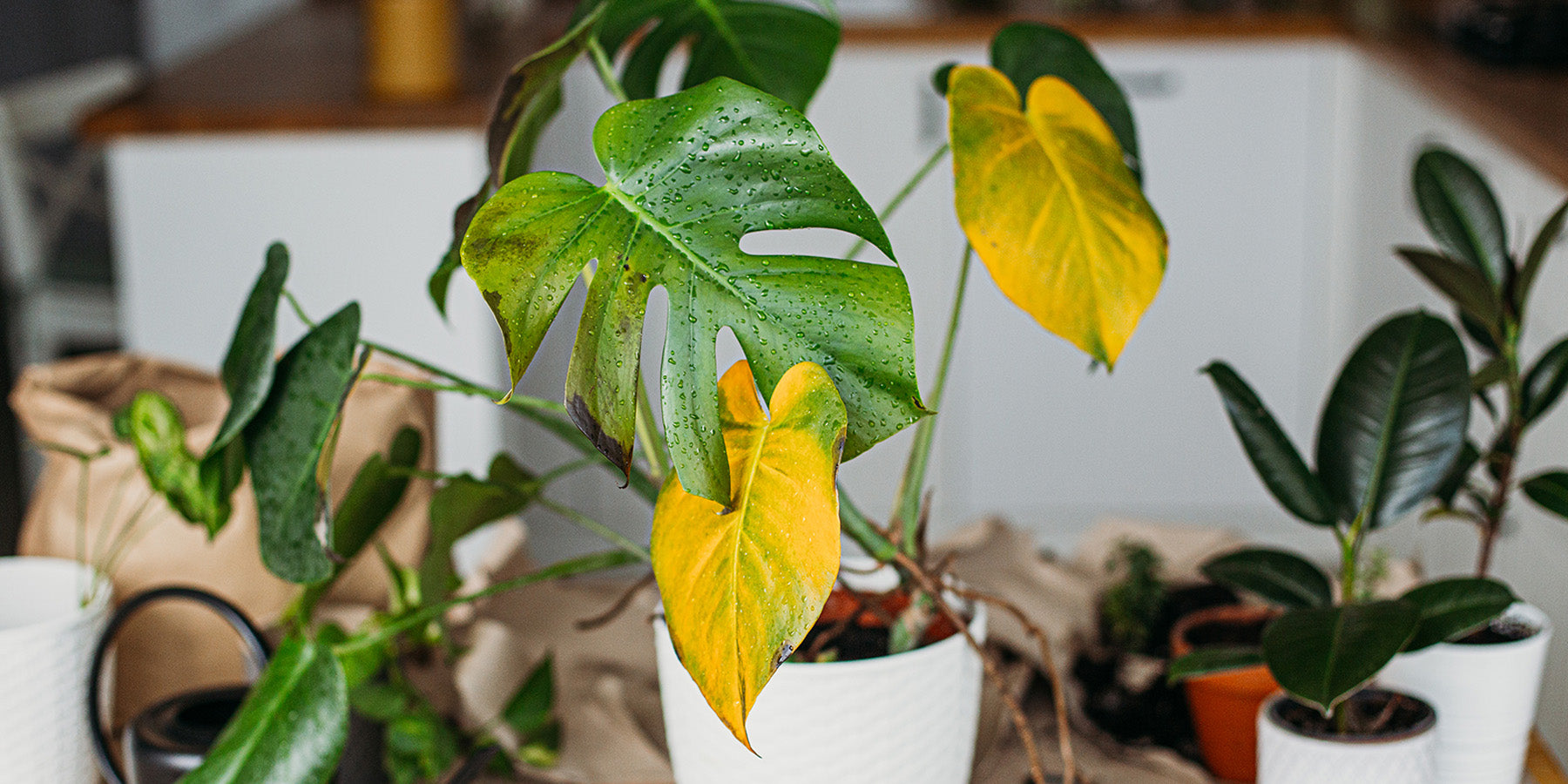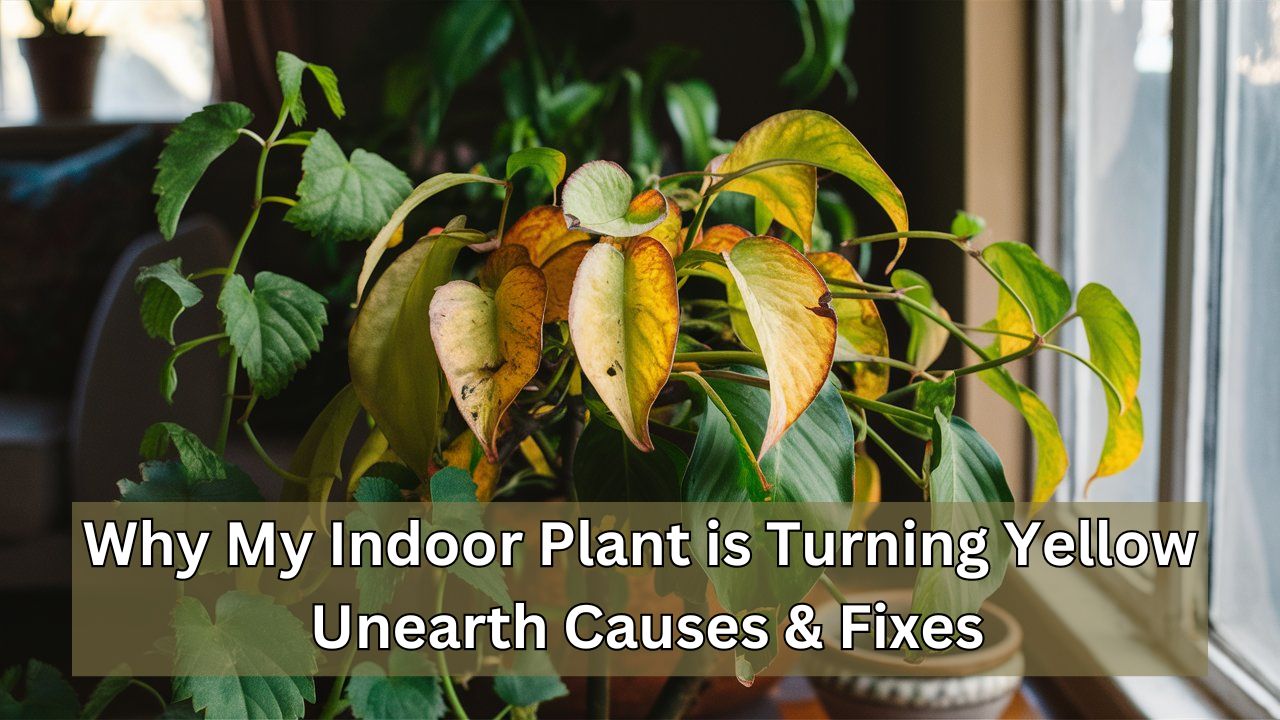Overwatering or poor drainage often causes indoor plants to turn yellow. Insufficient light or nutrient deficiencies can also be factors.
Yellowing leaves on indoor plants can be concerning for plant owners. Understanding the reasons behind this issue is crucial for maintaining plant health. Overwatering is a common culprit, leading to root rot and yellow leaves. Poor drainage exacerbates this problem, making it essential to ensure pots have adequate drainage holes.
Insufficient light can also cause yellowing, as plants struggle to photosynthesize effectively. Nutrient deficiencies, particularly a lack of nitrogen, may lead to discoloration. Observing and adjusting watering habits, ensuring proper light exposure, and providing necessary nutrients can help revive yellowing indoor plants. Regular monitoring and proper care are key to keeping indoor plants vibrant and healthy.

Credit: theplantrunner.com
Symptoms Beyond Yellow Leaves
Yellow leaves on indoor plants can signal distress. But other symptoms may be present. Knowing these signs helps you act quickly. This section explores other common symptoms.
Spotted Or Brown Patches
Spotted or brown patches often indicate a fungal infection. These patches can spread quickly. They usually start small and dark. Over time, they grow larger and merge. These patches may appear on leaves or stems.
You might also see yellow halos around the spots. This is a classic sign of leaf spot disease. Inspect your plant closely. Look for any unusual markings.
| Symptom | Possible Cause |
|---|---|
| Spotted Patches | Fungal Infection |
| Brown Patches | Leaf Spot Disease |
Wilting Or Drooping
Wilting or drooping leaves usually point to water issues. Too much or too little water can cause this. Overwatering drowns the roots. Underwatering leaves them dry. Both conditions stress the plant.
Touch the soil to check moisture levels. If it’s soggy, reduce watering. If it’s dry, water the plant. Proper balance is key for healthy plants.
- Check soil moisture regularly.
- Ensure proper drainage in pots.
- Adjust watering based on plant needs.
Other factors like poor lighting can also cause wilting. Ensure your plant gets enough light. Move it closer to a window if needed.
Watering Woes: Finding The Balance
Your indoor plant’s yellowing leaves might be due to watering problems. Balancing the right amount of water is crucial. Too much or too little can harm your plant. Let’s explore the signs of overwatering and underwatering to help you find that balance.
Overwatering Signs
Overwatering is a common issue for indoor plants. Here are some signs:
- Yellowing leaves: Leaves may turn yellow and feel soft.
- Wilting: The plant looks droopy, even if the soil is wet.
- Root rot: A foul smell or black, mushy roots indicate rot.
- Moldy soil: Fungal growth on the soil surface is a warning sign.
Check the soil moisture before watering again. Use a moisture meter or your finger to test the soil’s dryness. Allow the top inch of soil to dry out before the next watering.
Underwatering Symptoms
Underwatering can also cause yellow leaves. Look for these symptoms:
- Crispy leaves: Leaves turn yellow and feel dry and brittle.
- Soil pulling away: The soil shrinks from the pot edges.
- Slow growth: The plant grows slowly or stops growing.
- Drooping leaves: Leaves droop and look lifeless.
Ensure the plant receives enough water. Water thoroughly until it drains from the pot’s bottom. Avoid letting the plant sit in water to prevent root rot.
Finding the right balance in watering is key to healthy indoor plants. Regularly check for signs of overwatering or underwatering. Adjust your watering habits to keep your plants thriving.
Light: The Goldilocks Zone
Indoor plants need the right amount of light to thrive. Too much or too little light can turn their leaves yellow. Finding the perfect balance, or the “Goldilocks Zone,” is essential.
Too Much Sun
Plants exposed to excessive sunlight can get sunburned. This causes their leaves to turn yellow or brown. Look for these signs:
- Leaves with scorched edges
- Yellow spots or patches
- Wilting despite regular watering
To fix this, move the plant to a spot with indirect light. Use sheer curtains to filter intense sunlight. Monitor the plant for any new yellowing.
Not Enough Light
Plants also suffer from insufficient light. This can make their leaves yellow and weak. Signs of too little light include:
- Slow growth
- Leggy or stretched stems
- Leaves falling off easily
To help your plant, place it near a window with bright, indirect light. You can also use grow lights to supplement natural light. Ensure the light source is suitable for the plant type.
| Problem | Signs | Solution |
|---|---|---|
| Too Much Sun | Scorched edges, yellow spots | Move to indirect light |
| Not Enough Light | Slow growth, leggy stems | Provide bright, indirect light |
Nutritional Needs: The Role Of Fertilizer
Indoor plants need proper nutrients to stay green and healthy. Fertilizer provides essential elements that plants cannot get from soil alone. Using the right fertilizer can prevent yellow leaves and promote growth. Understanding the balance is key to a thriving indoor garden.
Overfertilization Hazards
Too much fertilizer can harm your plant. Overfertilization leads to a salt buildup in the soil. This can cause leaf burn and yellowing.
- Leaves may become brown at the edges.
- Plant growth may slow down.
- Soil may appear crusty or white on the surface.
If you notice these signs, reduce the amount of fertilizer used. Flush the soil with water to remove excess salts. Follow the recommended dosage for your specific plant.
Signs Of Nutrient Deficiency
If your plant lacks nutrients, it will show certain signs. Yellowing leaves are a common symptom. Different deficiencies affect plants in various ways.
| Deficiency | Symptoms |
|---|---|
| Nitrogen | Yellowing starts at the bottom leaves. |
| Potassium | Yellow edges on older leaves. |
| Iron | Yellowing between leaf veins. |
- Check for yellowing patterns on leaves.
- Adjust your fertilizer to meet your plant’s needs.
- Use a balanced, all-purpose fertilizer for most plants.
Regularly monitor your plants for any changes. Maintaining proper nutrient levels will keep your indoor garden vibrant and lush.
Pot And Soil: The Foundation Matters
Your indoor plant’s health starts with the right pot and soil. If your plant is turning yellow, the problem might be in these areas. Let’s dive deeper into how proper drainage and soil type can affect your plant’s health.
Proper Drainage
Proper drainage is crucial for your indoor plants. A pot without drainage holes can cause water to accumulate. This leads to root rot and yellow leaves.
- Always use pots with drainage holes.
- Ensure excess water can escape easily.
- Place a saucer under the pot to catch excess water.
Good drainage keeps roots healthy. Healthy roots mean green leaves.
Soil Type And Ph Level
The right soil type is essential for your plant. Different plants need different soil types.
| Plant Type | Ideal Soil |
|---|---|
| Succulents | Sandy soil |
| Ferns | Peat-based soil |
Check the pH level of the soil. Most plants prefer a pH between 6.0 and 7.0.
- Use a soil test kit to check pH levels.
- Adjust the soil pH with lime or sulfur if needed.
Proper soil type and pH level ensure your plant gets the nutrients it needs. This prevents yellow leaves and keeps your plant thriving.

Credit: www.reddit.com
Pests And Diseases: Silent Killers
Have you noticed your indoor plant turning yellow? Pests and diseases could be the silent culprits. These hidden threats can damage your beloved plants without you noticing. Let’s explore how pests and diseases can cause harm and what you should watch for.
Common Indoor Plant Pests
Pests are tiny but mighty troublemakers for indoor plants. Here are some common ones:
- Aphids: Small, green or black insects that suck plant sap.
- Spider Mites: Tiny red or yellow dots that create webbing on leaves.
- Mealybugs: White, cotton-like bugs found on stems and leaves.
- Scale Insects: Brown or black bumps that stick to plant stems.
Disease Symptoms To Watch For
Diseases can also cause yellowing leaves. Look out for these symptoms:
| Disease | Symptoms |
|---|---|
| Root Rot | Yellow leaves, mushy roots, and a foul smell. |
| Powdery Mildew | White, powdery spots on leaves and stems. |
| Leaf Spot | Brown or black spots on leaves, causing yellowing. |
To keep your plants healthy, check them regularly. Early detection can save your plants from these silent killers. Happy gardening!
Environmental Stress Factors
Environmental stress factors can significantly affect the health of your indoor plants. These factors can cause your plant’s leaves to turn yellow. Identifying and addressing these issues is crucial for maintaining vibrant, green foliage.
Temperature Fluctuations
Indoor plants are sensitive to temperature fluctuations. Sudden changes in temperature can stress them. Most plants prefer a stable temperature range. Avoid placing plants near drafts or heating vents.
Extreme cold or heat can cause yellowing leaves. Check your home’s temperature regularly. Use a thermometer to monitor the environment. Maintaining a consistent temperature can prevent stress.
Humidity Concerns
Humidity levels are vital for indoor plants. Low humidity can dry out leaves. High humidity can lead to mold or fungal issues. Both conditions can cause yellowing leaves.
Use a humidity meter to check levels. Most indoor plants thrive in 40-60% humidity. If your home is dry, consider using a humidifier. Grouping plants can also increase humidity naturally.
| Environmental Factor | Ideal Condition | Potential Issues |
|---|---|---|
| Temperature | 65-75°F (18-24°C) | Yellow leaves, wilting |
| Humidity | 40-60% | Dry leaves, mold |
Addressing these environmental factors can help keep your plants healthy. Monitor your indoor environment and make necessary adjustments.

Credit: m.youtube.com
Reviving Your Yellowing Plant
Yellowing leaves can be a sign of distress in indoor plants. Don’t panic. Instead, take action to revive your plant. This guide will help you bring your plant back to life. Follow the steps below to ensure your plant gets the care it needs.
Assess And Adjust Care Routine
First, check your plant’s watering schedule. Overwatering is a common cause of yellow leaves. Make sure the soil is not too wet. Allow the top inch of soil to dry before watering again.
Check the light conditions as well. Most indoor plants need bright, indirect light. Move your plant closer to a window if needed. Avoid direct sunlight, which can scorch the leaves.
Temperature and humidity also play a role. Ensure your plant is in a room with stable temperatures. Indoor plants prefer temperatures between 65°F and 75°F. Increase humidity with a humidifier or a water tray.
When To Consult A Professional
If your plant’s condition does not improve, consider seeking help. A professional can diagnose issues that are hard to identify. This includes root rot, pests, and diseases.
Here is a simple table to determine when to consult a professional:
| Condition | Action |
|---|---|
| Yellowing persists despite care adjustments | Consult a professional |
| Visible signs of pests or mold | Seek expert advice |
| Plant shows no new growth | Contact a specialist |
Professionals can provide tailored solutions. They might suggest specific fertilizers or treatments. Don’t hesitate to reach out for help if needed.
Frequently Asked Questions
How Do You Fix Yellowing Plants?
Fix yellowing plants by ensuring proper watering, improving soil drainage, and providing adequate sunlight. Check for pests and nutrient deficiencies. Adjust fertilization as needed.
Can Yellow Leaves Turn Green Again?
Yellow leaves rarely turn green again. Focus on improving plant care to prevent further yellowing. Ensure proper watering, lighting, and nutrient levels.
Why Are Indoor Plant Leaves Going Yellow?
Indoor plant leaves turn yellow due to overwatering, poor drainage, or lack of sunlight. Check for pests and nutrient deficiencies.
Should You Remove Yellow Leaves From Plants?
Yes, remove yellow leaves to promote plant health. Yellow leaves can indicate disease or nutrient deficiencies. Removing them improves appearance and growth.
Conclusion
Yellowing leaves can be a sign of various issues. Ensure proper watering, lighting, and nutrients for your indoor plants. Regularly check for pests and diseases. With proper care, your plant will thrive and regain its green foliage. Happy gardening and enjoy your vibrant indoor greenery!

My mission is to help you bring the beauty of nature indoors with expert advice, detailed plant care guides, and creative design ideas.




